

[
] 22
This maximalist interpretation of the WPS agenda establishes
three broad categories for action, namely protection and human
rights issues; peace and security issues; and gender equality and
the empowerment of women issues. These categories overlap,
are context-specific, and are mutually supportive. For instance,
investing in post-conflict governance generally contributes to
all three categories; however, when designed under the context
of a WPS agenda, its contributions are better guaranteed to
respond to women, peace and security priorities.
To achieve the commendable dual goal of the WPS agenda,
a new generation of development policies, institutions and
working methods is needed. They need to be viable, effec-
tive and conducive particularly in fragile and conflict-affected
settings such as those of the Arab region today. This requires us
to think of the factors that underscore the fragility of develop-
ment gains in the face of instability and conflict, and how to
invest in policies, institutions and systems that are resilient and
able to advance the WPS agenda including in times of volatility.
This question underscores much of the thinking on WPS
across the Arab region. Several states have initiated the design
and implementation of national action plans dedicated to the
WPS agenda, listing activities that fall under the three pillars of
WPS, albeit focusing mainly on the third pillar on the advance-
ment of women. However, these national actions plans are
unique and represent a leap forward in the sense that their
cross-sectoral approach includes actions falling within the
mandates of civilian as well as security sector actors. These
actions range from combating violence against women and
provision of social services, to terrorism prevention and peace-
keeping. These national action plans therefore represent a new
generation of development policies that include peace and
security elements at their core, thereby representing the new
mindset of peace for development and development for peace.
A case in point is the Iraq national action plan on WPS. This
action plan included a range of activities that go beyond the
advancement of women per se. For example the action plan
includes particular activities to promote women’s participa-
tion in security sector activities such as war theatre planning
and activities during live combat operations. In fact, the emer-
gency national action plan, devised as a spin-off of the national
action to mitigate the impacts of military operations against
the Islamic State on civilian populations, went a step further to
include gender sensitization, capacity development, and miti-
gation measures focusing on military commanders and officers
participating in this offensive prior to their deployment.
Another example is from Palestine, where the national
action plan on WPS was developed through two tracks. The
first is a government-led track with civil society participation,
while the second is a purely civil society track. The Palestine
national action plan has included a particular emphasis on
highlighting and documenting the human rights violations
committed by Israeli occupation against Palestinian women
and girls, towards the international prosecution to end the de
facto impunity and deliver justice.
While these two examples showcase how national action
plans were designed to advance both developmental as well as
peace and security goals, the new paradigm also includes a shift
in the design, structures and working methods of institutions
Image: ©Anis Mahyoub, 2016
Women have joined pro-government militias to fight against coup forces trying to overtake the Yemeni city of Taiz
A B
etter
W
orld
















